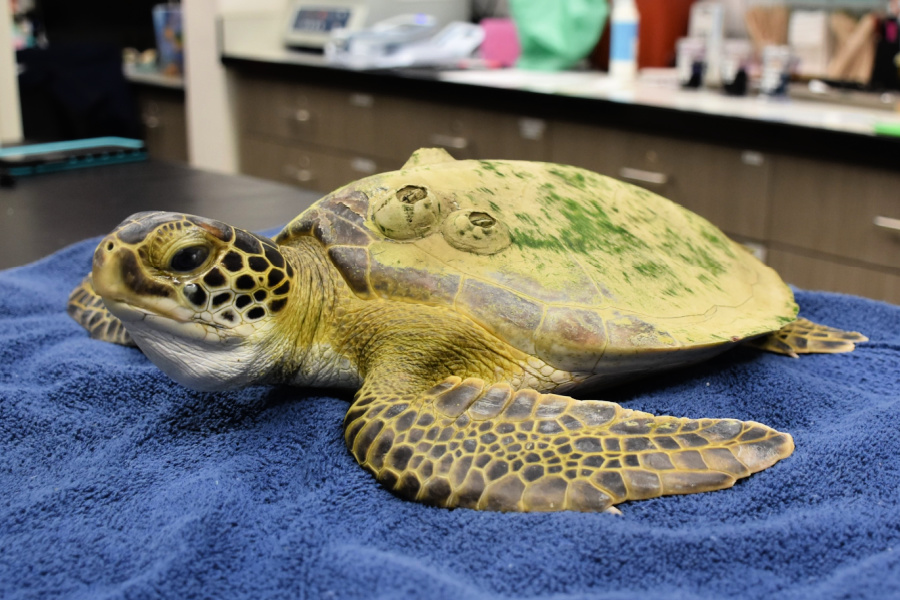Green (Chelonia mydas)
Stranding Location: Bowens Island, Charleston, SC
Arrival Date: 7/28/23
Age: Juvenile
Sex: Unknown
Weight: 2.29 kg (5.05 lbs)
Case History
Burrata was found floating and unable to dive by Charleston Outdoor Adventure staff in King Flats Creek near Bowens Island. Staff notified the South Carolina Department of Natural Resources (SCDNR) who directed them to retrieve the turtle until SCDNR could arrive to transport the patient to the South Carolina Aquarium for treatment.
Treatment
Upon initial examination, Burrata exhibited labored breathing with raspy sounding breaths. Blood work revealed that the turtle’s carbon dioxide levels were very high, indicating that the patient was struggling to breathe and struggling to absorb oxygen on their own. Radiographs were taken to rule out any obvious obstructions in the throat, and Burrata was put on supplemental oxygen. The radiographs revealed that the patient had patchy, opaque lung tissue and a full GI tract. Vet staff decided to CT scan the turtle for a more detailed view of the trachea and lungs. The CT scan confirmed that Burrata had pneumonia and that the trachea was obstructed.
To further investigate the blockage, Burrata was mildly sedated and intubated for a bronchoscopy. A bronchoscopy procedure uses a long, slender probe with a camera on the end to scope down the throat of the turtle to get a visual view of the trachea and the blockage. The entrance of the trachea was inflamed. Further down to the bifurcation (or the branching of the trachea to each lung) there was a large mucous plug blocking the primary bronchi openings, a result of the pneumonia. To unclog the mucous, vet staff flushed the trachea with sterile saline and a sample was taken for further analysis of a potential bacterial or fungal infection. Burrata’s sedation was reversed following the procedure. The patient was given fluids, vitamins, antibiotics, an inflammatory medication and was wet docked overnight to rest from the procedure. Burrata’s breaths were noticeably less audible and the turtle exhibited more natural, relaxed respiration.
Update
July 29, 2023: Burrata’s bloodwork was checked the next morning and it revealed normal levels of gas exchange in their blood, a great sign that the turtle’s airway was no longer obstructed! The patient was active and taking good breaths and staff felt secure in trying the turtle in water. With the expectation of buoyancy and respiration issues, Burrata was placed in less than half a tank of water. It was a great surprise to staff to see this turtle level out in the water column, swim calmly, breathe evenly and easily, and rest on the bottom of the tank with no issue whatsoever! Burrata even passed multiple fecals, signaling that the GI tract is functioning properly! We’ll be offering a couple pieces of fish and a leaf of lettuce to test the patient’s appetite tomorrow.
August 15, 2023: Burrata is eating everything in sight and is a defecating machine. This is great news as this patient’s GI tract was very full on admit and is now moving properly. We have not noticed any more raspy breathing, and the antibiotics will improve lung function and clear any further mucous formation. As Burrata has not has any signs of buoyancy control issues, we are also increasing the water depth of the tank weekly. Things are looking up for Burrata!
September 15, 2023: This past month staff was noticing that Burrata was having more frequent defecations than normal. There are many things that can cause this, but staff thought it would be worth trying a probiotic to help Burrata’s gut. After about two weeks on this medication we saw Burrata’s fecal output return to normal!
October 15, 2023: Burrata got a large upgrade this month and is now in the largest and deepest tank we have! You can now see Burrata in Zucker Family Sea Turtle Recovery™. S/he is definitely a star up there, always spending time in front of the window and interacting with enrichment.
November 15, 2023: Due to Burrata’s lung infections it’s important for the lungs to be exercised by diving deep and swimming throughout a large area. Burrata gets this exercise daily in our biggest tank in Zucker Family Sea Turtle Recovery™. This past month, Burrata has enjoyed a variety of enrichments like a large hula hoop, a backscratcher and Halloween-themed fish pops!
December 15, 2023: Burrata continues to exercise her/his lungs in the largest tank in the Care Center. This patient is making excellent progress, but still needs to gain some more weight before being ready to return to the wild. In the meantime, come check Burrata out in Zucker Family Sea Turtle Recovery™. You might even see this turtle interacting with enrichment, such as a hula hoop!
January 15, 2024: Burrata continues to exercise her/his lungs in the biggest tank in the Care Center by swimming throughout the tank and interacting with a variety of enrichments. As Burrata gains weight, s/he is getting closer to being evaluated for release. Come see Burrata in Zucker Family Sea Turtle Recovery™!
February 15, 2024: Burrata has been a superstar in our deep tank, showing us that there are no lung capacity issues when diving. Burrata was tagged earlier this month and we are awaiting bloodwork results to determine if this little green will be cleared for release!
February 26, 2024: Today Burrata made a trip to Florida’s warmer waters and was successfully released at Little Talbot Island State Park along with nine other rehabilitated patients! Wish Burrata the best of luck out in the big blue!


